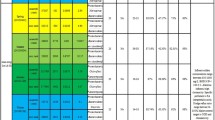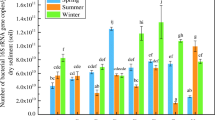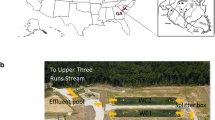Abstract
The characteristics of the microbial community in a practical-scale down-flow hanging sponge (DHS) reactor, high in organic matter and sulfate ion concentration, and the seasonal variation of the microbial community composition were investigated. Microorganisms related to sulfur oxidation and reduction (2–27%), as well as Leucobacter (7.50%), were abundant in the reactor. Anaerobic bacteria (27–38% in the first layer) were also in abundance and were found to contribute to the removal of organic matter from the sewage in the reactor. By comparing the Simpson index, the abundance-based coverage estimator (ACE) index, and the species composition of the microbial community across seasons (summer/dry, summer/rainy, autumn/dry, and winter/dry), the microbial community was found to change in composition only during the winter season. In addition to the estimation of seasonal variation, the difference in the microbial community composition along the axes of the DHS reactor was investigated for the first time. Although the abundance of each bacterial species differed along both axes of the reactor, the change of the community composition in the reactor was found to be greater along the vertical axis than the horizontal axis of the DHS reactor.






Similar content being viewed by others
References
Agrawal LK, Okui H, Ueki Y, Harada H, Ohashi A (1997) Treatment of raw sewage in a temperate climate using a UASB reactor and the hanging sponge cubes process. Water Sci Technol 36:433–440
APHA (2005) Standard methods, 21st ed. Washington DC, pp 4–136–140
Asano R, Nakai Y, Kawada W, Shimura Y, Inamoto T, Fukushima J (2013) Seawater inundation from the 2011 Tohoku tsunami continues to strongly affect soil bacterial communities 1 year later. Microb Ecol 66(3):639–646
Clarke KR, Warwick RM (2001) Change in marine communities: an approach to statistical analysis and interpretation, 2nd edn. Natural Environment Research Council, Plymouth Marine Laboratory, Plymouth
Flaherty KE, Matheson RE Jr, McMichael RH Jr, Perry WB (2013) The influence of freshwater on nekton community structure in hydrologically distinct basins in Northeastern Florida Bay, FL, USA. Estuar Coasts 36:918–939
Garrity P (2009) Bergey’s manual of systematic bacteriology, vol 3: the Firmicutes. 737. https://doi.org/10.1007/978-0-387-68489-5
Halpern M, Shakéd T, Pukall R, Schumann P (2009) Leucobacter chironomi sp. nov., a chromate resistant bacterium isolated from a chironomid egg mass. Int J Syst Evol Microbiol 59:665–670
Iguchi A, Okubo T, Tachibana M, Nagai H, Uemura S, Yamaguchi T, Kubota K, Harada H (2013) Bacterial community structure of practical-scale DHS reactor treating municipal wastewater by UASB-DHS system and quantification of denitrifying bacteria. J Jpn Soc Civil Eng Ser G (Environ Res) 69(7):III_539–III_546 (in Japanese)
Ju F, Zhang T (2015) Bacterial assembly and temporal dynamics in activated sludge of a full-scale municipal wastewater treatment plant. ISME J 9(3):683–695
Ju F, Guo F, Ye L, Xia Y, Zhang T (2014) Metagenomic analysis on seasonal microbial variations of activated sludge from a full-scale wastewater treatment plant over 4 years. Environ Microbiol Rep 6(1):80–89
Kim N-K, Oh S, Liu W-T (2016) Enrichment and characterization of microbial consortia degrading soluble microbial products discharged from anaerobic methanogenic bioreactors. Water Res 90:395–404
Kubota K, Hayashi M, Matsunaga K, Iguchi A, Ohashi A, Li YY, Yamaguchi T, Harada H (2014) Microbial community composition of a down-flow hanging sponge (DHS) reactor combined with an up-flow anaerobic sludge blanket (UASB) reactor for the treatment of municipal sewage. Bioresour Technol 151:144–150
Kuhl M, Jorgensen BB (1992) Microsensor measurements of sulfate reduction and sulfide oxidation in compact microbial communities of aerobic biofilms. Am Soc Microbiol 58(4):1164–1174
Kuroda K, Chosei T, Nakahara N, Hatamoto M, Wakabayashi T, Kawai T, Araki N, Syutsubo K, Yamaguchi T (2015) High organic loading treatment for industrial molasses wastewater and microbial community shifts corresponding to system development. Bioresour Technol 196:225–234
Lee SH, Kang HJ, Park HD (2015) Influence of influent wastewater communities on temporal variation of activated sludge communities. Water Res 73(15):132–144
Levén L, Eriksson ARB, Schnürer A (2006) Effect of process temperature on bacterial and archaeal communities in two methanogenic bioreactors treating organic household waste. Fed Eur Microbiol Soc 59:683–693
Liao J, Fang C, Yu J, Sathyagal A, Willman E, Liu W-T (2017) Direct treatment of high-strength soft drink wastewater using a down-flow hanging sponge reactor: performance and microbial community dynamics. Appl Microbiol Biotechnol 101:5925–5936
Liu L, Liu M, Wilkinson DM, Chen H, Yu X, Yang J (2017) DNA metabarcoding reveals that 200-μm-size-fractionated filtering is unable to discriminate between planktonic microbial and large eukaryotes. Mol Ecol Resour
Ma A, Wen X, Zhao F, Xi Y, Huang X, Waite D, Guan J (2013) Effect of temperature variation on membrane fouling and microbial community structure in membrane bioreactor. Bioresour Technol 133:462–468
Machdar I, Sekiguchi Y, Sumino H, Ohashi A, Harada H (2000) Combination of a UASB reactor and a curtain type DHS (downflow hanging sponge) reactor as a cost-effective sewage treatment system for developing countries. Water Sci Technol 42:83–88
Meerbergen K, Geel MV, Waud M, Willems KA, Dewil R, Impe JV, Appels L, Lievens B (2017) Assessing the composition of microbial communities in textile wastewater treatment plants in comparison with municipal wastewater treatment plants. Microbiol Open 6(1):1–13
Nomoto N, Ali M, Jayaswal K, Iguchi A, Hatamoto M, Okubo T, Takahashi M, Kubota K, Tagawa T, Uemura S, Yamaguchi T, Harada H (2017a) Characteristics of DO, organic matter, and ammonium profile for practical-scale DHS reactor under various organic load and temperature conditions. Environ Technol, in press
Nomoto N, Ali M, Jayaswal K, Iguchi A, Hatamoto M, Okubo T, Takahashi M, Kubota K, Tagawa T, Uemura S, Yamaguchi T, Harada H (2017b) Removal and oxygen consumption of retained sludge for organic matter, ammonium, and sulfur in a practical-scale down-flow hanging sponge sewage treatment reactor. In Proceedings of 6th annual international conference on sustainable energy and environmental sciences (SEES 2017), pp 52-58
Oksanen J, Blanchet FG, Kindt R, Legendre P, Minchin PR, O'Hara RB, Simpson GL, Solymos P, Stevens MHH, Wagner H (2016) Vegan: community ecology package. R package version 2.3–4
Okubo T, Kubota K, Yamaguchi T, Uemura S, Harada H (2016) Development of a new non-aeration-based sewage treatment technology: performance evaluation of a full-scale down-flow hanging sponge reactor employing third-generation sponge carriers. Water Res 102:138–146
Onodera T, Tandukar M, Sugiyama D, Uemura S, Ohashi A, Harada H (2014) Development of a sixth-generation down-flow hanging sponge (DHS) reactor using rigid sponge media for post-treatment of UASB treating municipal sewage. Bioresour Technol 152:93–100
Sato N, Okubo T, Onodera T, Ohashi A, Harada H (2006) Prospects for a self-sustainable sewage treatment system: a case study on full-scale UASB system in India’s Yamuna River basin. J Environ Manag 80:198–207
Sturm G, Jacobs J, Sproer C, Schumann P, Gescher J (2011) Leucobacter chromiiresistens sp. nov., a chromate-resistant strain. Int J Syst Evol Microbiol 61:956–960
Tandukar M, Uemura S, Ohashi A, Harada H (2006) Combining UASB and the “fourth generation” down-flow hanging sponge reactor for municipal wastewater treatment. Water Sci Technol 53:209–218
Tandukar M, Ohashi A, Harada H (2007) Performance comparison of a pilot scale UASB and DHS system and activated sludge process for the treatment of municipal wastewater. Water Res 41:2697–2705
Tang JC, Shibata A, Zhou Q, Katayama A (2007) Effect of temperature on reaction rate and microbial community in composting of cattle manure with rice straw. J Biosci Bioeng 104(4):321–328
Tawfik A, Ohashi A, Harada H (2006) Sewage treatment in a combined up-flow anaerobic sludge blanket (UASB)—down-flow hanging sponge (DHS) system. Biochem Eng J 29:210–219
Wang X, Wen X, Yan H, Ding K, Zhao F, Hu M (2011) Bacterial community dynamics in a functionally stable pilot-scale wastewater treatment plant. Bioresour Technol 102:2352–2357
Wang X, Hu M, Xia Y, Wen X, Ding K (2012) Pyrosequencing analysis of bacterial diversity in 14 wastewater treatment systems in China. Appl Environ Microbiol 78(19):7042–7047
Xin X, He J, Wang Y, Feng J, Qiu W (2016) Role of aeration intensity on performance and microbial community profiles in a sequencing batch reaction kettle (SBRK) for wastewater nutrients rapid removal. Bioresour Technol 201:140–147
Yergeau E, Lawrence JR, Sanschagrin S, Waiser MJ, Korber DR, Greera CW (2012) Next-generation sequencing of microbial communities in the Athabasca River and its tributaries in relation to Oil Sands mining activities. Appl Environ Microbiol 78(21):7626–7637
Zhang T, Shao MF, Ye L (2012) 454 pyrosequencing reveals bacterial diversity of activated sludge from 14 sewage treatment plants. ISME J 6(6):1137–1147
Zheng D, Sun Y, Li H, Lu S, Shan M, Xu S (2016) Multistage A-O activated sludge process for paraformaldehyde wastewater treatment and microbial community structure analysis. J Chem 2016:7
Acknowledgments
We are grateful to the National River Conservation Directorate (NRCD); Ministry of Environment, Forest and Climate Change (MOEF); the Indian government; and Uttar Pradesh Jal Nigam (UPJN) for extending various forms of assistance. We also thank Mr. A. Noori and Mr. P. Sjati for contributing to the experiments in India.
Funding
This study was funded by the Science and Technology Research Partnership for Sustainable Development (SATREPS) in Japan.
Author information
Authors and Affiliations
Corresponding author
Ethics declarations
Conflict of interest
The authors declare that they have no conflict of interest.
Ethical approval
This article does not contain any studies with animals performed by any of the authors.
Electronic supplementary material
ESM 1
(PDF 289 kb)
Rights and permissions
About this article
Cite this article
Nomoto, N., Hatamoto, M., Hirakata, Y. et al. Defining microbial community composition and seasonal variation in a sewage treatment plant in India using a down-flow hanging sponge reactor. Appl Microbiol Biotechnol 102, 4381–4392 (2018). https://doi.org/10.1007/s00253-018-8864-1
Received:
Revised:
Accepted:
Published:
Issue Date:
DOI: https://doi.org/10.1007/s00253-018-8864-1




